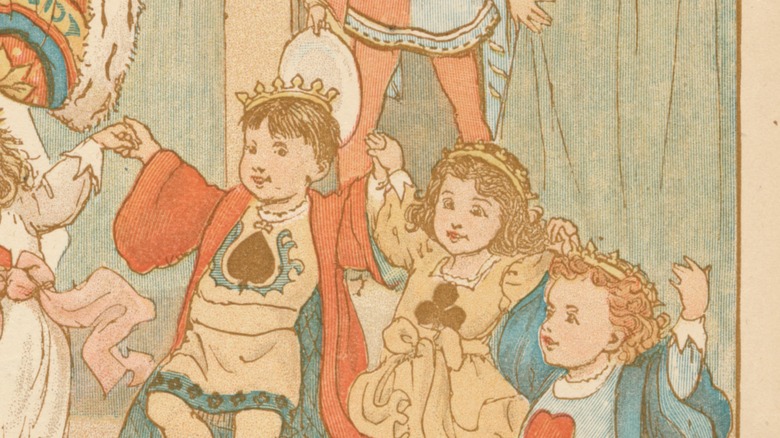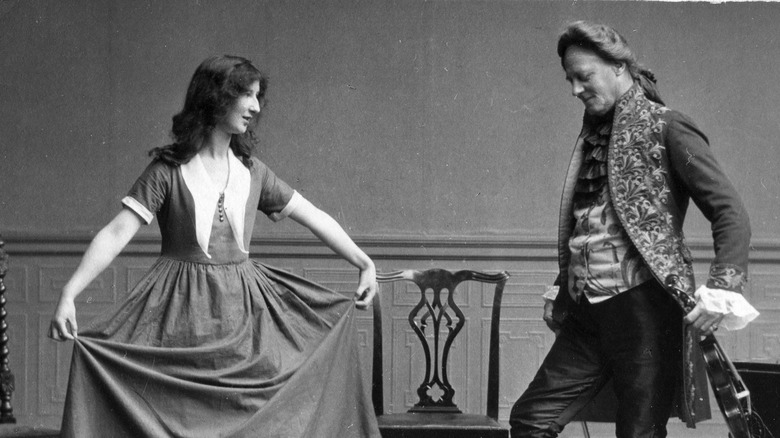The Origins Of Ring Around The Rosie Aren't What You Think
Would you believe that the origins of nursery rhymes are often dark and violent? That these verses for children often conceal terrible truths from history, unbeknownst to the adults blithely reciting them to their toddlers? That the truth about "Ring Around the Rosie" is that it's about the Black Plague?
If you do, then we've got a bridge to sell you. While there's a seemingly insatiable demand for dark, gritty reboots of nursery rhymes like "Humpty Dumpty" and "Ring Around the Rosie," the disappointing (to some) truth is that they're probably exactly what they appear to be: silly nonsense for children. Let's take a look at the claims about "Rosie," and then make quick work of it.
The most popular version of "Ring Around the Rosie" goes something like this: "Ring around the rosie / A pocket full of posies / Ashes, ashes / We all fall down." According to the legend, "Rosie" was written during the time of the Black Plague, with each line referring to a stage in the disease's progression. The "Ring around the rosie" was a round, red rash that would form; the "pocket full of posies" refers to the superstitious practice of carrying flowers to ward off the disease; "Ashes, ashes" is onomatopoeia for sneezing; and "We all fall down" refers to the inevitable death (via Sewer History). Got all that? Good. Here's why every word of it is wrong.
Sorry, it's just a silly children's rhyme
So, here's the main reason we can be sure "Ring Around the Rosie" isn't about the Black Death: the Plague's symptoms just don't match up with the supposed meaning of the rhyme. The bubonic plague results in buboes — swollen areas — but they're not especially red or "rosie" in color. It does have a respiratory variant, but that particular form of it is associated with coughing and wheezing — not sneezing (via the Centers for Disease Control and Prevention). It does result in death, though, so points for that, we guess.
The second nail in this theory's coffin is the fact that "Ring Around the Rosie" wasn't written down until 1881 — half a millennium after the first outbreak of the Black Death. And even then, no one publishing the written rhyme seemed to know about its dark origins — or at least didn't think to mention them. The earliest references we have to the plague interpretation date back to after World War II (via Snopes).
Third, while there seems to be a considerable conviction that this rhyme is definitely about the Black Plague, no one can agree on which aspects of the plague it's actually referencing. Depending on who you ask, the "pocket full of posies" might reference either an attempt to ward off bad smells or the tradition of placing flowers on graves, while "Ashes, ashes" could reference either sneezing or the need to cremate infected bodies. Oh, and it gets even worse.
Here's the real origin of Ring Around the Rosie
The final death knell for the plague claim is that there's just no consistency at all in the lyrics of "Ring Around the Rosie." While the most currently-most-popular version of the rhyme can sort of be twisted to sound plague-y, there were countless variations on it, and many have no references to ashes or pocketed posies at all (via Library of Congress). One version from 1883, for instance, goes as follows: "Round the ring of roses / Pots [not pockets!] full of posies / The one stoops the last /Shall tell whom she loves the best." The idea that the one version that somehow survived into the present happened, by chance, to be the one that carries the "true" meaning is just ... a little far-fetched.
So what actually is "Ring Around the Rosie"? The most commonly accepted interpretation among folklorists is that it's the lyrics to something called a "play party." An awful lot of Victorian-era Protestant sects attempted to ban dancing, which didn't sit well with the teens. Eventually, the teens got around this edict by holding "play parties," where they'd stand in circles and chant rhymes while doing motions (via Snopes). It was basically singing and dancing, but just different enough that the authorities looked the other way — and it was so much fun, the younger kids started doing it too. That might not be quite as badass as the thought of some medieval kids singing and dancing around plague corpses, but come on: "Victorian-era 'Footloose'" is still pretty cool.


